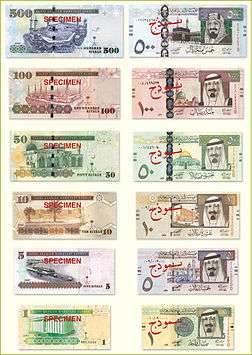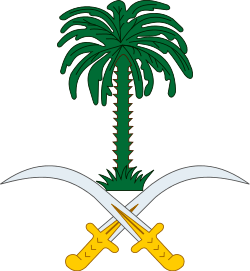Saudi riyal
| Saudi riyal | |
|---|---|
| ريال سعودي(Arabic) | |
|
The fifth series of the Saudi Arabian Riyal | |
| Denominations | |
| Subunit | |
| 1⁄100 | halalah |
| Symbol | ر.س (Arabic), SR (Latin), ﷼ (Unicode) |
| Banknotes | 1, 5, 10, 50, 100, 500 riyals |
| Coins | 5, 10, 25, 50, 100 halalas |
| Demographics | |
| User(s) |
|
| Issuance | |
| Monetary authority | Saudi Arabian Monetary Agency |
| Website | www.sama.gov.sa |
| Valuation | |
| Inflation | 3% (December 2013) |
| Source | Saudi Arabian Monetary Agency, Jan 2014 est. |
The Saudi riyal (Arabic: ريال riyāl; ISO 4217 code: SAR is the currency of Saudi Arabia. It is abbreviated as ر.س or SR (Saudi riyal). It is subdivided into 100 halalas (Arabic: هللة Halalah). The Saudi qirsh is 5 halalas.
History
The riyal has been the currency of Saudi Arabia since the country came into being and was the currency of Hejaz before Saudi Arabia was created, one of the primary currencies in the Mediterranean region during the Ottoman era. The Hejaz riyal was based on but not equivalent to the Ottoman 20 kuruş coin and was consequently divided into 20 qirsh. However, although the Hejaz riyal was the same weight as the Ottoman 20 kuruş, it was minted in .917 fineness, compared to .830 fineness for the Ottoman coin. Thus, because the first Saudi riyal had the same specifications as the Hejaz riyal and circulated alongside Ottoman coins, it came to be worth 22 Ottoman kuruş and was consequently subdivided into 22 ghirsh when coins denominated in qirsh were issued from 1925. The system remained even though the riyal was subsequently debased to a coin equivalent, in silver content, to the Indian rupee in 1935.
In 1960, the system was changed to 20 qirsh to a riyal, which was followed in 1963 by the introduction of the halala, one hundredth of a riyal. Some Saudi coins still bear denominations in qirsh, but it is no longer commonly used.
Coins
| 100 Halalah (1 Saudi riyal) | |
|---|---|
.jpg) | |
| Obverse: Crossed swords and palm tree at center flanked by dates, legend above and below.
Lettering: خالد بن عبد العزيز آل سعود (Khalid ibn Abd al-Aziz al-Saud) and |
Reverse: Value and year written in Arabic. |
| Total 30,250,000 coins minted in 1976 & 1980. | |
In 1925, transitional copper coins for 1⁄4 and 1⁄2 qirsh (in some parts of the country, it is pronounced girsh) were minted in Makkah by Ibn Saud. They were followed, in 1926, by 1⁄4, 1⁄2 and 1 qirsh cupro-nickel pieces carrying the title "King of Hejaz and Sultan of Nejd".
In 1927, the royal title was changed to "King of Hejaz and Nejd and Dependencies" and coins were issued in denominations of 1⁄4, 1⁄2 and 1 qirsh in cupro-nickel and 1⁄4, 1⁄2 and 1 riyal in silver.
In 1935, the first coins were issued in the name of Saudi Arabia. These were silver 1⁄4, 1⁄2 and 1 riyal coinswhich were nearly 50% lighter than the previous issue. Cupro-nickel 1⁄4, 1⁄2 and 1 qirsh were also issued from 1937. In 1946 (AH 1365), many of the cupro-nickel coins were countermarked with the Arabic numerals 65 (٦٥) in what Krause and Mishler describe as "a move to break money changers' monopoly on small coins". Cupro-nickel 2 and 4 qirsh were introduced in 1957.
In 1963, the halala was introduced, and bronze 1 halala coins were issued. That was the only year they were struck. Cupro-nickel 5, 10, 25 and 50 halala followed in 1972, inscribed with their denomination in ghirsh or riyal (1, 2 qirsh, 1⁄4, 1⁄2 riyal). In 1976, cupro-nickel 1 riyal coins were introduced, which are also inscribed with the denomination 100 halala. Bimetallic 1 riyal coins, also marked 100 halala, were issued in 1999.
Banknotes

In 1953, the Saudi Arabian Monetary Agency (SAMA) began issuing Haj Pilgrim Receipts for 10 riyals,[1] with 1 and 5 riyals following in 1954 and 1956, respectively. These resembled banknotes and were initially intended for use by pilgrims who exchanged foreign currency for them. However, they became widely accepted in Saudi Arabia and largely replaced silver riyal coins in major financial transactions. Consequently, the Monetary Agency began issuing regular banknotes for 1, 5, 10, 50 and 100 riyals on 15 June 1961. The Pilgrim Receipts were withdrawn on 1 February 1965.[2]
500 Riyal notes were introduced in 1983. 20 and 200 riyal banknotes were issued in 2000 to commemorate the centenary of the founding of what became the Kingdom of Saudi Arabia. The 5th series of banknotes bearing the face of King Abdullah were issued in 2007.
Series 5
On May 20, 2007, "the Saudi Arabian Monetary Agency, pursuant to article (4) of the Saudi Currency Law, issued under the Royal Decree No. (6) and dated 1/7/1379H." announced the fifth domination of the Saudi riyal that features King Abdullah Bin Abdulaziz's picture on all notes except the 500 riyal, which features King Abdulaziz Al Saud. The 100 and 50 riyal notes were released on May 21, 2007. The 10 and 5 riyal notes followed in June 2007, then the 500 riyal followed in September 2007, and finally the 1 riyal note completed the series in December 2007. It is expected by the SAMA that the fourth (current) series will take approximately two years to phase out, although a complete removal of the current series require more than two years since the fourth series has been in circulation for well over 25 years. The fourth series which feature King Fahad's picture will remain legal tender under the Saudi Arabian monetary law. The new series have the latest and most advanced security system to prevent from counterfeiting and other similar activities.
| Banknotes of the Saudi riyal (5th series)[3] | ||||||||
|---|---|---|---|---|---|---|---|---|
| Image | Value | Dimensions | Main Color | Description | Date of issue | Date of first issue | Watermark | |
| Obverse | Reverse | |||||||
| 1 riyal | 133 x 63 mm | Light green | 7th century gold dinar coin; King Abdullah Bin Abdul-Aziz al-Saud | SAMA headquarters building | 2007 | December 31, 2007 | King Abdullah Bin Abdul-Aziz al-Saud, electrotype 1, Cornerstones | |
| 5 riyals | 145 x 66 mm | Violet | Ras Tanorah oil refinery; King Abdullah Bin Abdul-Aziz al-Saud | Ras Tanorah tanker loading terminal, Jubayl Port in the eastern region | 2007 | July 2007 | King Abdullah Bin Abdul-Aziz al-Saud, electrotype 5, Cornerstones | |
| 10 riyals | 150 x 68 mm | Brown | King Abdulaziz’s palace in Almoraba; King Abdullah Bin Abdul-Aziz al-Saud | King Abdul Aziz Historical Center, Riyadh | 2007 | July 2007 | King Abdullah Bin Abdul-Aziz al-Saud, electrotype 10, Cornerstones | |
| 50 riyals | 155 x 70 mm | Dark green | Dome of the Rock in Jerusalem; King Abdullah Bin Abdul-Aziz al-Saud | Al-Aqsa Mosque in Jerusalem | 2007 | May 21, 2007 | King Abdullah Bin Abdul-Aziz al-Saud, electrotype 50, Cornerstones | |
| 100 riyals | 160 x 72 mm | Red | Green Dome of The Prophet’s Mosque in Medina; King Abdullah Bin Abdul-Aziz al-Saud | The Prophet’s Mosque in Al Madinah Al Monawarah | 2007 | May 21, 2007 | King Abdullah Bin Abdul-Aziz al-Saud, electrotype 100, Cornerstones | |
| 500 riyals | 166 x 74 mm | Blue | Ka'aba in Mecca; King Abdulaziz Al Saud | Holy mosque in Makkah Al Mukarramah (Mecca) | 2007 | September 2007 | King Abdulaziz Al Saud, electrotype 500, Cornerstones | |
Fixed exchange rate
In June 1986, the riyal was officially pegged to the IMF's special drawing rights (SDRs). In practice, it is fixed at 1 U.S. dollar = 3.75 riyals, which translates to approximately 1 riyal = 0.266667 dollar.[4][5] This rate was made official on January 1, 2003.
The riyal briefly rose to a 20-year high after the US Federal Reserve cut interest rates on September 18, 2007 and the SAMA chose not to follow suit, partially due to concerns about the inflationary effects low interest rates and a lower value for the riyal.[6][7] The riyal returned to its peg against the U.S. dollar in early December 2007.[8][9]
| Current SAR exchange rates | |
|---|---|
| From Google Finance: | AUD CAD CHF EUR GBP HKD JPY USD INR CNY |
| From Yahoo! Finance: | AUD CAD CHF EUR GBP HKD JPY USD INR CNY |
| From XE: | AUD CAD CHF EUR GBP HKD JPY USD INR CNY |
| From OANDA: | AUD CAD CHF EUR GBP HKD JPY USD INR CNY |
| From fxtop.com: | AUD CAD CHF EUR GBP HKD JPY USD INR CNY |
Note: Rates obtained from these websites may contradict pegged rate mentioned above
Proposed monetary union
Saudi Arabia is a member of the Cooperation Council for the Arab States of the Gulf, which planned a monetary union with a single currency by 2010.[8][10] However, all GCC countries operate with their own currency so far.
See also
References
- ↑
- ↑ Linzmayer, Owen (2012). "Saudi Arabia". The Banknote Book. San Francisco, CA: www.BanknoteNews.com.
- ↑ http://banknotenews.com/files/ef40a6db5320aa1a18c8bf4992a1cda7-51.php
- ↑ Saudi Arabia’s Exchange Rate Arrangement
- ↑ In this special feature Central Banking presents a survey of the Saudi Arabian Monetary Agency
- ↑ "Gulf States Consider Revaluing Currencies, Person Familiar Says". Bloomberg. 17 November 2007.
- ↑ "Gulf Arab States May Revalue to Combat Inflation (Update1)". Bloomberg. 5 December 2007.
- 1 2 "GCC States Back 2010 Single Currency, Quiet on Dollar (Update2)". Bloomberg. 4 December 2007.
- ↑ "Gulf States May Have to Drop Pegs, Merrill, Bear Stearns Say". Bloomberg. 5 February 2008.
- ↑ Gulf Currency
- Krause, Chester L.; Clifford Mishler (1991). Standard Catalog of World Coins: 1801–1991 (18th ed.). Krause Publications. ISBN 0873411501.
- Pick, Albert (1994). Standard Catalog of World Paper Money: General Issues. Colin R. Bruce II and Neil Shafer (editors) (7th ed.). Krause Publications. ISBN 0-87341-207-9.
External links
- Saudi banknotes From the first edition to the special edition.
- http://www.islamicbanknotes.com/


